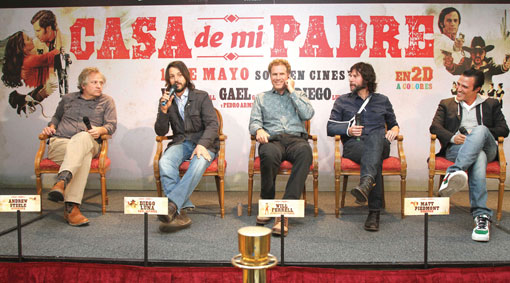The U.S. Drug Enforcement Administration agent loudly repeats his question: “Do…You…Speak…American?” Cowboy hat in hand, the humble Mexican rancher glances down before responding, “No señor, no hablo americano.” This scene, from the recently released film Casa de mi Padre (March 2012), could be depicting a tense moment at the U.S.–Mexico border—except that the Mexican cowboy is played by U.S. comedy star Will Ferrell.
The latest production by Nala (North America Latin America) Films studio—whose past releases have included Dan in Real Life and The Air I Breathe—Casa de mi Padre was shot entirely in Spanish (with English subtitles) with U.S., Mexican and U.S. Hispanic audiences in mind. And Ferrell, whose pronunciation is flawless even though he admits to not understanding Spanish, isn’t the only gringo practicing rolling his r’s these days. Abbie Cornish (Limitless, 2011) recently learned Spanish to play the lead in The Girl, Indy director David Riker’s new bilingual movie, screened at the Tribeca Film Festival in March, which also takes place on the border.
The drift toward bilingual films in the U.S. not only reflects a burgeoning Hispanic audience but also reflects a more general trend toward bilingualism in music and the arts (think megastars Ricky Martin or Shakira). With good reason: Hispanics are the largest and fastest-growing ethnic group in the country, exceeding 50 million in 2011.
U.S. Hispanics have wide-ranging levels of cultural assimilation and Spanish- and English- language abilities, but nearly everyone watches movies. According to the Motion Picture Association of America, Hispanics accounted for 30 percent of frequent moviegoers in 2010. Films such as Spanglish (2004), Nacho Libre (2006) and the upcoming biopic Chavez, about the life of Mexican labor activist Cesar Chavez, attempt to find the right combination of language and culture that will appeal to the vast Latin crossover market. One difference between Casa, The Girl, and earlier flicks is that both were explicitly marketed to both native English and Spanish speakers—in an effort to appeal to the lucrative market of Latin Americans, U.S. Hispanics and gringos who may or may not focus on Latin America.
Leonel Limonte, head of New England Festival of Ibero-American Cinema, thinks Spanish in U.S. movies is here to stay. The “New Latin American Cinema” of the 1960s and 1970s portrayed Latin Americans fighting against dictators and the U.S. But what Limonte calls the “New New Latin American Cinema” tells more intimate, universal stories to which audiences can relate regardless of their cultural backgrounds. If current movie-making and demographic trends are any indicators, the linguistic and cultural lines in North American film will be increasingly blurry in coming years.




